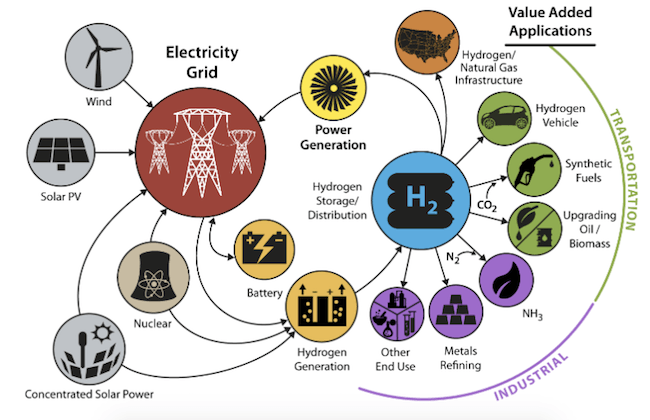
The U.S. has its sights set on a "deep decarbonization" goal for the national economy, and it looks like hydrogen will play a key role in getting there. That may seem like a bit of an oxymoron if the hydrogen comes from conventional fossil sources.
However, wind and solar power are coming into play. A new round of $30 million in Energy Department funding indicates the U.S. is serious about getting on track for a sustainable hydrogen economy based on renewable energy.
$30 million more for the hydrogen economy
For those of you new to the topic, fuel cells produce electricity by combining hydrogen with oxygen. Fuel cells could replace batteries as the go-to mode of power for the emerging zero-emissions electric vehicle market. They potentially offer longer range at a lower cost, but there are a number of major obstacles to hurdle before fuel cell technology catches up to the current crop of battery EVs.
The $30 million in new funding will go to ramp up the Energy Department's existing Energy Materials Network.
The network was launched to support the domestic hydrogen and fuel cell industries with foundational research resources at the agency's national laboratories. The areas of research include renewable hydrogen and advanced materials for less expensive, more efficienct fuel cells.
The programs include the Electrocatalysis Consortium. This group is tackling one major obstacle, which is the cost of the catalyst needed to generate electricity in a fuel cell. Platinum is now the go-to catalyst but that means high cost, price volatility and supply issues. The hunt is on for low-cost, high-efficiency catalysts made from abundant materials.
Another group, dubbed the HydroGEN Consortium, is tasked with scaling up technologies to produce hydrogen from water, using renewable energy.
The Hydrogen Materials—Advanced Research Consortium is the third group in the new round of funding. This group is working on key issues for hydrogen in the mobility sector. One of those is how to provide for the safe storage of hydrogen on board a vehicle. The current method of choice is in a pressurized tank, and the group is looking at the potential for solid-state storage materials that act more like sponges.
The hydrogen economy is booming
Hydrogen is an abundant fuel, but its relatively low energy density kept it in the shadows. That is beginning to change now that the technology is catching up.
According to the Energy Department, the global market is booming:
"... Hydrogen and fuel cells continue to grow at an unprecedented rate, with more than 60,000 fuel cells, totaling roughly 300 megawatts (MW), shipped worldwide in 2015. The number of MW shipped grew by more than 65 percent compared to 2014. 2015 also saw the world’s first fuel cell vehicles for sale."
Developments on the fuel cell electric vehicle (FCEV) scene include Honda's Clarity. Earlier this week, Honda announced it will have a five-passenger edition of its Clarity FCEV on the road in California before the end of the year.
In case you're wondering why the vehicle will only be available in California, that's because you can find hydrogen fueling stations there thanks to a statewide initiative that includes Honda and other stakeholders. Elsewhere in the nation, the hydrogen network has yet to ramp up.
Honda notes that the Clarity has a range of about 300 miles or more, and it can refuel in five minutes or less. That compares favorably with the numbers for battery EVs and conventional gas-powered vehicles.
Another fuel cell early adopter is Toyota, which introduced the Mirai last year. Toyota has also launched an ambitious initiative in two Japanese cities that deploys wind energy to power the local economy.
GM entered the FCEV market in partnership with the U.S. Army. The company recently unveiled a fuel cell version of its Chevrolet Colorado, the Colorado ZH2. Here's a snippet from the press release detailing why the Army is so interested in hydrogen-powered mobility:
- Near-silent operation enabling silent watch capability
- Reduced acoustic and thermal signatures
- High wheel torque at all speeds via electric drive
- Low fuel consumption across operating range
- Water by-product for field uses
Fuel cell vehicles can also be hooked up to microgrids and provide power for stationary operations.
Beyond passenger cars
Aside from serving the motoring public, fuel cells are finding their way into the shipping and logistics field. The zero-emission angle is important for warehouse and seaport operations, and the quick refueling dovetails with the need for tight scheduling.
Fuel cells are also working their way into mass transit. One recent example is Ohio's Stark Area Regional Transit Authority, which just sent the first of its new fuel cell bus fleet on the road.
Another example is mobility company Alstom, which just introduced a fuel cell version of its popular diesel-powered urban passenger train in Europe.
Image (screenshot): via U.S. Department of Energy.

Tina writes frequently for TriplePundit and other websites, with a focus on military, government and corporate sustainability, clean tech research and emerging energy technologies. She is a former Deputy Director of Public Affairs of the New York City Department of Environmental Protection, and author of books and articles on recycling and other conservation themes.














